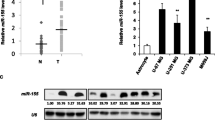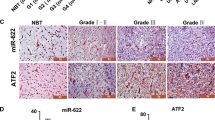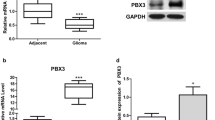Abstract
Glioblastoma multiforme (GBM) is the most common primary brain tumor in adults. The extraordinary invasion of human GBM into adjacent normal brain tissues contributes to treatment failure. However, the mechanisms that control this process remain poorly understood. Increasing evidence has demonstrated that microRNAs are strongly implicated in the migration and invasion of GBM. In this study, we found that microRNA-98 (miR-98) was markedly downregulated in human glioma tissues and cell lines. Functional experiments indicated that restored expression of miR-98 attenuated glioma cell invasion and migration, whereas depletion of miR-98 promoted glioma cell invasion and migration. Subsequent investigation showed that pre-B-cell leukemia homeobox 3 (PBX3), an important transcription factor that controls tumor invasion, was a direct and functional target of miR-98 in GBM cells. Consistently, an orthotopic mouse model also demonstrated the suppressive effects of miR-98 overexpression on tumor invasion and PBX3 expression. Silencing of PBX3 using small interfering RNA inhibited the migratory and invasive capacities of glioma cells, whereas reintroduction of PBX3 into glioma cells reversed the anti-invasive function of miR-98. Furthermore, depletion of PBX3 phenocopied the effects of miR-98 overexpression in vivo. Finally, quantitative real-time polymerase chain reaction results showed that miR-98 was negatively correlated with PBX3 expression in 24 glioma tissues. Thus, we propose that PBX3 modulation by miR-98 has an important role in regulating GBM invasion and may serve as therapeutic target for GBM.






Similar content being viewed by others
References
Alajez NM, Shi W, Hui AB, Bruce J, Lenarduzzi M, Ito E, Yue S, O’Sullivan B, Liu FF (2010) Enhancer of Zeste homolog 2 (EZH2) is overexpressed in recurrent nasopharyngeal carcinoma and is regulated by miR-26a, miR-101, and miR-98. Cell Death Dis 1:e85. doi:10.1038/cddis.2010.64
Auffinger B, Thaci B, Ahmed A, Ulasov I, Lesniak MS (2013) MicroRNA targeting as a therapeutic strategy against glioma. Curr Mol Med 13(4):535–542
Bartel DP (2004) MicroRNAs: genomics, biogenesis, mechanism, and function. Cell 116(2):281–297
Calin GA, Croce CM (2006) MicroRNA signatures in human cancers. Nat Rev Cancer 6(11):857–866. doi:10.1038/nrc1997
Chang CP, Brocchieri L, Shen WF, Largman C, Cleary ML (1996) Pbx modulation of Hox homeodomain amino-terminal arms establishes different DNA-binding specificities across the Hox locus. Mol Cell Biol 16(4):1734–1745
Chen Z, Cheng Q, Ma Z, Xi H, Peng R, Jiang B (2013) Overexpression of RKIP inhibits cell invasion in glioma cell lines through upregulation of miR-98. BioMed research Int 2013:695179. doi:10.1155/2013/695179
Chen C, Cao F, Bai L, Liu Y, Xie J, Wang W, Si Q, Yang J, Chang A, Liu D, Liu D, Chuang TH, Xiang R, Luo Y (2015a) IKKbeta enforces a LIN28B/TCF7L2 positive feedback loop that promotes cancer cell stemness and metastasis. Cancer Res 75(8):1725–1735. doi:10.1158/0008-5472.can-14-2111
Chen W, Zhang B, Guo W, Gao L, Shi L, Li H, Lu S, Liu Y, Li X (2015b) miR-429 inhibits glioma invasion through BMK1 suppression. J Neurooncol 125(1):43–54. doi:10.1007/s11060-015-1887-x
Dolecek TA, Propp JM, Stroup NE, Kruchko C (2012) CBTRUS statistical report: primary brain and central nervous system tumors diagnosed in the United States in 2005–2009. Neuro-oncology 14(Suppl 5):v1–49. doi:10.1093/neuonc/nos218
Du Y, Li Y, Lv H, Zhou S, Sun Z, Wang M (2015) miR-98 suppresses tumor cell growth and metastasis by targeting IGF1R in oral squamous cell carcinoma. Int J Clin Exp Pathol 8(10):12252–12259
Duan R, Han L, Wang Q, Wei J, Chen L, Zhang J, Kang C, Wang L (2015) HOXA13 is a potential GBM diagnostic marker and promotes glioma invasion by activating the Wnt and TGF-beta pathways. Oncotarget 6(29):27778–27793. doi:10.18632/oncotarget.4813
Errico MC, Felicetti F, Bottero L, Mattia G, Boe A, Felli N, Petrini M, Bellenghi M, Pandha HS, Calvaruso M, Tripodo C, Colombo MP, Morgan R, Care A (2013) The abrogation of the HOXB7/PBX2 complex induces apoptosis in melanoma through the miR-221&222-c-FOS pathway. Int J Cancer 133(4):879–892. doi:10.1002/ijc.28097
Fan YH, Ye MH, Wu L, Lv SG, Wu MJ, Xiao B, Liao CC, Ji QK, Chai Y, Zhu XG (2015) Overexpression of miR-98 inhibits cell invasion in glioma cell lines via downregulation of IKKepsilon. Eur Rev Med Pharmacol Sci 19(19):3593–3604
Han HB, Gu J, Zuo HJ, Chen ZG, Zhao W, Li M, Ji DB, Lu YY, Zhang ZQ (2012) Let-7c functions as a metastasis suppressor by targeting MMP11 and PBX3 in colorectal cancer. J Pathol 226(3):544–555. doi:10.1002/path.3014
Han HB, Gu J, Ji DB, Li ZW, Zhang Y, Zhao W, Wang LM, Zhang ZQ (2014) PBX3 promotes migration and invasion of colorectal cancer cells via activation of MAPK/ERK signaling pathway. World J Gastroenterol 20(48):18260–18270. doi:10.3748/wjg.v20.i48.18260
Han H, Du Y, Zhao W, Li S, Chen D, Zhang J, Liu J, Suo Z, Bian X, Xing B, Zhang Z (2015) PBX3 is targeted by multiple miRNAs and is essential for liver tumour-initiating cells. Nat Commun 6:8271. doi:10.1038/ncomms9271
Han SY, Han HB, Tian XY, Sun H, Xue D, Zhao C, Jiang ST, He XR, Zheng WX, Wang J, Pang LN, Li XH, Li PP (2016) MicroRNA-33a-3p suppresses cell migration and invasion by directly targeting PBX3 in human hepatocellular carcinoma. Oncotarget. doi:10.18632/oncotarget.9886
Hebert C, Norris K, Scheper MA, Nikitakis N, Sauk JJ (2007) High mobility group A2 is a target for miRNA-98 in head and neck squamous cell carcinoma. Mol Cancer 6:5. doi:10.1186/1476-4598-6-5
Hong CS, Jeong O, Piao Z, Guo C, Jung MR, Choi C, Park YK (2015) HOXB5 induces invasion and migration through direct transcriptional up-regulation of beta-catenin in human gastric carcinoma. Biochem J 472(3):393–403. doi:10.1042/bj20150213
Huang SD, Yuan Y, Zhuang CW, Li BL, Gong DJ, Wang SG, Zeng ZY, Cheng HZ (2012) MicroRNA-98 and microRNA-214 post-transcriptionally regulate enhancer of zeste homolog 2 and inhibit migration and invasion in human esophageal squamous cell carcinoma. Mol Cancer 11:51. doi:10.1186/1476-4598-11-51
Lefranc F, Brotchi J, Kiss R (2005) Possible future issues in the treatment of glioblastomas: special emphasis on cell migration and the resistance of migrating glioblastoma cells to apoptosis. J Clin Oncol 23(10):2411–2422. doi:10.1200/jco.2005.03.089
Li Z, Zhang Z, Li Y, Arnovitz S, Chen P, Huang H, Jiang X, Hong GM, Kunjamma RB, Ren H, He C, Wang CZ, Elkahloun AG, Valk PJ, Dohner K, Neilly MB, Bullinger L, Delwel R, Lowenberg B, Liu PP, Morgan R, Rowley JD, Yuan CS, Chen J (2013) PBX3 is an important cofactor of HOXA9 in leukemogenesis. Blood 121(8):1422–1431. doi:10.1182/blood-2012-07-442004
Li F, Li XJ, Qiao L, Shi F, Liu W, Li Y, Dang YP, Gu WJ, Wang XG, Liu W (2014a) miR-98 suppresses melanoma metastasis through a negative feedback loop with its target gene IL-6. Exp Mol Med 46:e116. doi:10.1038/emm.2014.63
Li Y, Sun Z, Zhu Z, Zhang J, Sun X, Xu H (2014b) PBX3 is overexpressed in gastric cancer and regulates cell proliferation. Tumour Biol 35(5):4363–4368. doi:10.1007/s13277-013-1573-6
Lin X, Chen L, Yao Y, Zhao R, Cui X, Chen J, Hou K, Zhang M, Su F, Chen J, Song E (2015) CCL18-mediated down-regulation of miR98 and miR27b promotes breast cancer metastasis. Oncotarget 6(24):20485–20499. doi:10.18632/oncotarget.4107
Liu X, Zhang W, Guo H, Yue J, Zhuo S (2016) miR-98 functions as a tumor suppressor in salivary adenoid cystic carcinomas. OncoTargets Ther 9:1777–1786. doi:10.2147/OTT.S98534
Lu J, Getz G, Miska EA, Alvarez-Saavedra E, Lamb J, Peck D, Sweet-Cordero A, Ebert BL, Mak RH, Ferrando AA, Downing JR, Jacks T, Horvitz HR, Golub TR (2005) MicroRNA expression profiles classify human cancers. Nature 435(7043):834–838. doi:10.1038/nature03702
Lu Y, Wu D, Wang J, Li Y, Chai X, Kang Q (2016) miR-320a regulates cell proliferation and apoptosis in multiple myeloma by targeting pre-B-cell leukemia transcription factor 3. Biochem Biophys Res Commun 473(4):1315–1320. doi:10.1016/j.bbrc.2016.04.069
Magnani L, Patten DK, Nguyen VT, Hong SP, Steel JH, Patel N, Lombardo Y, Faronato M, Gomes AR, Woodley L, Page K, Guttery D, Primrose L, Fernandez Garcia D, Shaw J, Viola P, Green A, Nolan C, Ellis IO, Rakha EA, Shousha S, Lam EW, Gyorffy B, Lupien M, Coombes RC (2015) The pioneer factor PBX1 is a novel driver of metastatic progression in ERalpha-positive breast cancer. Oncotarget 6(26):21878–21891. doi:10.18632/oncotarget.4243
Ni R, Huang Y, Wang J (2015) miR-98 targets ITGB3 to inhibit proliferation, migration, and invasion of non-small-cell lung cancer. OncoTargets Ther 8:2689–2697. doi:10.2147/ott.s90998
Onishi M, Ichikawa T, Kurozumi K, Date I (2011) Angiogenesis and invasion in glioma. Brain Tumor Pathol 28(1):13–24. doi:10.1007/s10014-010-0007-z
Paw I, Carpenter RC, Watabe K, Debinski W, Lo HW (2015) Mechanisms regulating glioma invasion. Cancer Lett 362(1):1–7. doi:10.1016/j.canlet.2015.03.015
Ramberg H, Alshbib A, Berge V, Svindland A, Tasken KA (2011) Regulation of PBX3 expression by androgen and Let-7d in prostate cancer. Mol Cancer 10:50. doi:10.1186/1476-4598-10-50
Ramberg H, Grytli HH, Nygard S, Wang W, Ogren O, Zhao S, Lovf M, Katz B, Skotheim RI, Bjartell A, Eri LM, Berge V, Svindland A, Tasken KA (2016) PBX3 is a putative biomarker of aggressive prostate cancer. Int J Cancer 139(8):1810–1820. doi:10.1002/ijc.30220
Shah N, Sukumar S (2010) The Hox genes and their roles in oncogenesis. Nat Rev Cancer 10(5):361–371. doi:10.1038/nrc2826
Siragam V, Rutnam ZJ, Yang W, Fang L, Luo L, Yang X, Li M, Deng Z, Qian J, Peng C, Yang BB (2012) MicroRNA miR-98 inhibits tumor angiogenesis and invasion by targeting activin receptor-like kinase-4 and matrix metalloproteinase-11. Oncotarget 3(11):1370–1385. doi:10.18632/oncotarget.717
Smits M, Nilsson J, Mir SE, van der Stoop PM, Hulleman E, Niers JM, de Witt Hamer PC, Marquez VE, Cloos J, Krichevsky AM, Noske DP, Tannous BA, Wurdinger T (2010) miR-101 is down-regulated in glioblastoma resulting in EZH2-induced proliferation, migration, and angiogenesis. Oncotarget 1(8):710–720. doi:10.18632/oncotarget.101207
Stupp R, Mason WP, van den Bent MJ, Weller M, Fisher B, Taphoorn MJ, Belanger K, Brandes AA, Marosi C, Bogdahn U, Curschmann J, Janzer RC, Ludwin SK, Gorlia T, Allgeier A, Lacombe D, Cairncross JG, Eisenhauer E, Mirimanoff RO (2005) Radiotherapy plus concomitant and adjuvant temozolomide for glioblastoma. N. Engl. J Med 352(10):987–996. doi:10.1056/NEJMoa043330
Swartz MA, Iida N, Roberts EW, Sangaletti S, Wong MH, Yull FE, Coussens LM, DeClerck YA (2012) Tumor microenvironment complexity: emerging roles in cancer therapy. Cancer Res 72(10):2473–2480. doi:10.1158/0008-5472.can-12-0122
Ting HJ, Messing J, Yasmin-Karim S, Lee YF (2013) Identification of microRNA-98 as a therapeutic target inhibiting prostate cancer growth and a biomarker induced by vitamin D. J Biol Chem 288(1):1–9. doi:10.1074/jbc.M112.395947
Van Meir EG, Hadjipanayis CG, Norden AD, Shu HK, Wen PY, Olson JJ (2010) Exciting new advances in neuro-oncology: the avenue to a cure for malignant glioma. CA Cancer J Clin 60(3):166–193. doi:10.3322/caac.20069
Wang H, Liu G, Shen D, Ye H, Huang J, Jiao L, Sun Y (2015) HOXA1 enhances the cell proliferation, invasion and metastasis of prostate cancer cells. Oncol Rep 34(3):1203–1210. doi:10.3892/or.2015.4085
Wei F, Wang Q, Su Q, Huang H, Luan J, Xu X, Wang J (2016a) miR-373 inhibits glioma cell U251 migration and invasion by down-regulating CD44 and TGFBR2. Cell Mol Neurobiol. doi:10.1007/s10571-016-0338-3
Wei YB, Liu JJ, Villaescusa JC, Aberg E, Brene S, Wegener G, Mathe AA, Lavebratt C (2016b) Elevation of Il6 is associated with disturbed let-7 biogenesis in a genetic model of depression. Transl Psychiatry 6:e869. doi:10.1038/tp.2016.136
Yang G, Zhang X, Shi J (2015) MiR-98 inhibits cell proliferation and invasion of non-small cell carcinoma lung cancer by targeting PAK1. Int J Clin Exp Med 8(11):20135–20145
Zhou W, Zou B, Liu L, Cui K, Gao J, Yuan S, Cong N (2016) MicroRNA-98 acts as a tumor suppressor in hepatocellular carcinoma via targeting SALL4. Oncotarget. doi:10.18632/oncotarget.12190
Acknowledgements
This work was funded by the National Natural Science Foundation of China (81300998 and 81471269), National Natural Science Foundation of Jiangsu Province (BK20131022 and BK20160047), Jiangsu Province's Key Discipline of Medicine (XK201117), Jiangsu Province and the Priority Academic Program Development of Jiangsu Higher Education Institutions (PAPD), and the Specially Appointed Professor Foundation of Jiangsu Province (ky216r201307).
Author contributions
Xiupeng Xu and Zhongyuan Bao wrote the manuscript. Xiupeng Xu and Zhongyuan Bao performed and analyzed experiments and prepared the figures. Yinlong Liu and Jing Ji conceived experiments. Ning Liu and Jing Ji assisted with data analysis. All authors reviewed the manuscript.
Author information
Authors and Affiliations
Corresponding authors
Ethics declarations
Conflict of interest
The authors declare no conflicts of interest.
Additional information
Xiupeng Xu and Zhongyuan Bao contributed equally to this work.
Rights and permissions
About this article
Cite this article
Xu, X., Bao, Z., Liu, Y. et al. MicroRNA-98 Attenuates Cell Migration and Invasion in Glioma by Directly Targeting Pre-B Cell Leukemia Homeobox 3. Cell Mol Neurobiol 37, 1359–1371 (2017). https://doi.org/10.1007/s10571-017-0466-4
Received:
Accepted:
Published:
Issue Date:
DOI: https://doi.org/10.1007/s10571-017-0466-4




